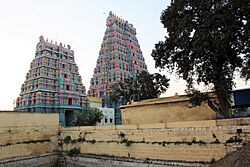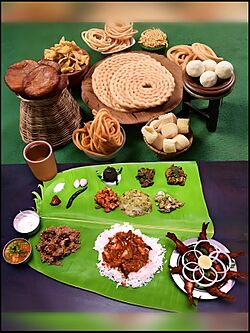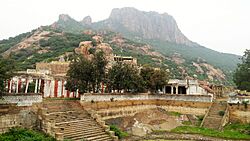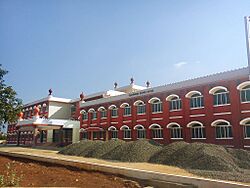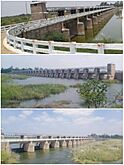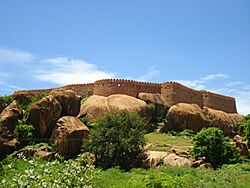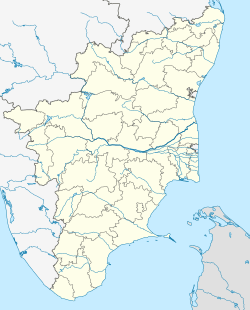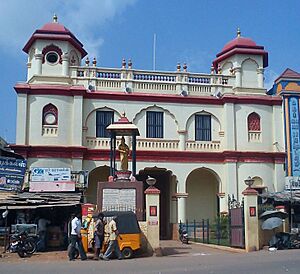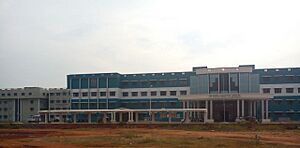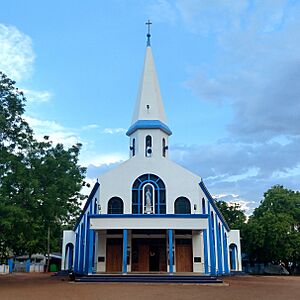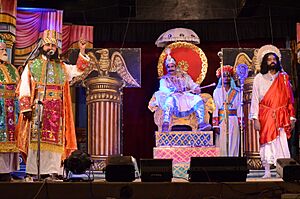Sivaganga facts for kids
Quick facts for kids
Sivaganga
Soil of Maruthu Brothers
|
|
|---|---|
|
Municipality
|
|
| Sivagangai | |
|
1) Kalayarkoil
2) Chettinad Cuisine 3) Piranmalai 4)District Court 5) Idaikattur Church 6) Parthibanur Dam 7) Tirumayam Fort |
|
| Nickname(s):
Sivagangai Seemai
|
|
| Country | |
| State | Tamil Nadu |
| District | Sivaganga |
| Region | Pandya Nadu |
| Government | |
| • Type | Municipality |
| • Body | Sivagangai Municipality |
| Area | |
| • Total | 43.28 km2 (16.71 sq mi) |
| Elevation | 124 m (407 ft) |
| Population | |
| • Total | 40,403 |
| • Rank | 2nd in sivagangai district |
| • Density | 11,588/km2 (30,010/sq mi) |
| Demonym(s) | Sivagangai kaaran(Male) Sivagangai kaari(Female) |
| Languages | |
| • Official | Tamil |
| Time zone | UTC+5:30 (IST) |
| PIN |
630561, 630562 & (623560 = old pincode)
|
| Telephone code | 04575 |
| Vehicle registration | TN-63 |
| Distance from Madurai | 40 kilometres (25 mi) WEST (Road) |
| Distance from Trichirapalli | 130 kilometres (81 mi) NORTH (Rail) |
| Distance from Rameswaram | 120 kilometres (75 mi) SOUTH (Rail) |
Sivaganga (pronounced si-va-gang-guy) is a city in the Indian state of Tamil Nadu. It is the main city and headquarters of the Sivaganga district. The city is famous for its old fort, built in the 16th century.
Inside the fort, you can find the Rajarajeshwari Amman Temple. This temple has many beautiful carvings. Close by, the Government Museum shows ancient items and displays about nature. There are also many other important places in Sivaganga. These include old monuments and temples. Some temples were built by kings like Muthuvaduganatha Thevar and the Maruthu brothers. Princess Velunachiyar also helped build and care for many temples. These places are still well-kept today.
Sivaganga is about 48 kilometers (30 miles) from Madurai. It is 449 kilometers (279 miles) from Chennai, the capital city of Tamil Nadu. The town is known for farming, metal work, and weaving. The area around Sivaganga also has many valuable minerals.
Sivaganga is part of an area that elects members to the state and national governments. Roads are the main way to travel to and from the town. It also has train connections. The closest major port is in Thoothukudi, about 189 kilometers (117 miles) away. The nearest airport is Madurai International Airport, which is about 53 kilometers (33 miles) from the city.
Contents
History of Sivaganga
- Further information: Sivaganga estate
In the 17th century, Sivaganga was part of the Ramnad Kingdom. This kingdom covered areas that are now Sivaganga, Pudukkottai, and Ramnathapuram. A king named Vijaya Raghunatha Sethupathi ruled from 1674 to 1710. After him, his sister's son became king.
Later, in 1726, his son-in-law, Sundareswara Ragunatha Sethupathy, took over. But Bavani Sankara Thevan, who was not a rightful heir, teamed up with the King of Tanjore. They attacked Ramnad. Bavani won, but he did not give the Tanjore King the land he had promised. Bavani then had a disagreement with Sasivarna Periya Oodaya Thevar and sent him away.
Sasivarna and Kattaya Thevar (Sundareswara's brother) then joined forces with the King of Tanjore. In 1730, they defeated Bavani with the help of Tanjore's army. Kattaya Thevar divided the kingdom into five parts. He gave two parts to Sasivarna, who became the first king of Sivaganga.
It is said that Sasivarna built a large pond called Teppakulam and a fort around a spring named "Sivaganga." This is where he met his spiritual teacher. Sasivarna became king around 1750. His son, Muthuvaduganatha Periya Udaya Thevar, became the next ruler. He was killed in 1780 by the Nawab's soldiers.
His wife, Velu Nachiyar, and their baby daughter, Vellacci, escaped. They were helped by two brave brothers, Periya Maruthu and Chinna Maruthu, known as the Maruthu brothers.
After the king's death in 1829, there was a long legal fight over who should rule next. From 1863 to 1877, Kathama Nachiar, a daughter, won the right to the title. However, she did not rule completely on her own. She faced many challenges. After India became independent in 1947, Sivaganga was part of the Ramnad district until 1984. Then, it became part of the new Sivaganga district.
Geography and Climate
Sivaganga is about 102 meters (334 feet) above sea level. The town has a tropical climate, which means it is usually warm. In summer, the highest temperature can be around 37°C (99°F). In winter, it is cooler, around 28°C (82°F). The lowest temperatures range from 23.9°C to 27.8°C (75°F to 82°F). The weather is generally pleasant throughout the year.
Most of the rain in Sivaganga comes during the northeast monsoon season. The town gets about 931 millimeters (36.7 inches) of rain each year.
| Climate data for Sivaganga | |||||||||||||
|---|---|---|---|---|---|---|---|---|---|---|---|---|---|
| Month | Jan | Feb | Mar | Apr | May | Jun | Jul | Aug | Sep | Oct | Nov | Dec | Year |
| Mean daily maximum °C (°F) | 28.6 (83.5) |
30.3 (86.5) |
32.1 (89.8) |
35.8 (96.4) |
37.0 (98.6) |
37.0 (98.6) |
34.9 (94.8) |
33.6 (92.5) |
33.5 (92.3) |
31.7 (89.1) |
30.1 (86.2) |
28.5 (83.3) |
32.8 (91.0) |
| Mean daily minimum °C (°F) | 23.9 (75.0) |
23.8 (74.8) |
24.8 (76.6) |
27.1 (80.8) |
27.8 (82.0) |
27.3 (81.1) |
26.7 (80.1) |
26.3 (79.3) |
26.0 (78.8) |
25.5 (77.9) |
24.7 (76.5) |
24.1 (75.4) |
25.7 (78.2) |
| Average rainfall mm (inches) | 30.4 (1.20) |
11.5 (0.45) |
18.1 (0.71) |
49.2 (1.94) |
75.1 (2.96) |
47.9 (1.89) |
64.2 (2.53) |
73.4 (2.89) |
91.7 (3.61) |
181.6 (7.15) |
196.5 (7.74) |
91.9 (3.62) |
931.5 (36.69) |
| Source: Climate Sivaganga | |||||||||||||
People and Population
| Religions in Sivaganga | ||||
|---|---|---|---|---|
| Religion | Percent(%) | |||
| Hindu | 84.75% | |||
| Muslim | 10.07% | |||
| Christian | 4.66% | |||
| Sikh | 0.02% | |||
| Buddhist | 0.01% | |||
| Other | 0.49% | |||
| Historical population | ||
|---|---|---|
| Year | Pop. | ±% |
| 1961 | 15,642 | — |
| 1971 | 20,826 | +33.1% |
| 1981 | 24,832 | +19.2% |
| 1991 | 33,190 | +33.7% |
| 2001 | 40,220 | +21.2% |
| 2011 | 92,359 | +129.6% |
| Sources: | ||
In 2011, Sivaganga had a population of 40,403 people. For every 1,000 males, there were 990 females. This is higher than the national average. About 3,880 children were under six years old.
Most people in Sivaganga can read and write. The average literacy rate was 83.86%. This is higher than the national average of 72.99%. The town had 10,184 households. Many people work in farming or other industries.
The population of Sivaganga has grown a lot over the years. Between 1991 and 2001, it grew by 25%. The number of people living per square kilometer has also increased.
In terms of religion, most people in Sivaganga are Hindus (84.75%). There are also many Muslims (10.07%) and Christians (4.66%). A small number of people follow other religions.
How Sivaganga is Governed
Sivaganga is the main city for the Sivaganga District. It is surrounded by other districts like Pudukkottai, Tiruchirapalli, Ramanathapuram, Virudhunagar, and Madurai. The Sivaganga District was created in July 1984 from the larger Ramnad District. The district courts are located in Sivaganga town. These courts work under the Madras High Court.
| Municipality Officials | |
|---|---|
| Chairman | M. Arujunan |
| Commissioner | K. Saravanan |
| Vice Chairman | V. Sekar |
| Elected Members | |
| Member of Legislative Assembly | Cholan CT. Palanichamy |
| Member of Parliament | Karti P. Chidambaram |
The local government of Sivaganga is called a municipality. It was set up in 1965 and became a first-grade municipality in 1998. The municipality manages an area of about 6.97 square kilometers (2.69 square miles). It has 27 members, one from each of the town's 27 areas, called wards.
The municipality has different departments that handle various tasks. These include general services, engineering, collecting money (revenue), public health, and town planning. A Municipal Commissioner is in charge of all these departments. The elected members, led by a Chairperson, make the laws for the town.
Sivaganga is part of the Sivaganga State Assembly Constituency. This means it elects one person to the Tamil Nadu Legislative Assembly every five years. The current elected member is Cholan CT. Palanichamy.
Sivaganga is also part of the Sivaganga (Lok Sabha constituency) for national elections. This area includes six different assembly constituencies. The current Member of Parliament (MP) for this area is Karti P. Chidambaram.
Getting Around Sivaganga
 |
tirupattur | Trichy | devakottai |  |
| madurai | kalaiyarkoil | |||
| Thirupachetti | manamadurai | Ramanathapuram |
Road Travel
Buses connect Sivaganga to nearby villages and towns like Devakottai and Kalayarkoil. The main bus stand in Sivaganga is a hub for these routes. State buses also offer long-distance travel to cities like Coimbatore and Chennai. There are 24-hour bus services to Madurai.
Many buses connect Sivaganga to other towns such as Karaikudi, Manamadurai, and Trichy. Major roads passing through Sivaganga include:
- National Highway 85 (Cochin-Madurai-Sivaganga-Thondi)
- NH 36 (Villupuram-Thanjavur-Sivaganga-Manamadurai)
- State Highway SH 34 (Ramanathapuram-Sivaganga-Melur)
Train Travel
The Sivaganga railway station is on the east side of town. It is part of the railway line that connects Trichy and Rameshwaram. This line also helps reduce train traffic on the main route from Virudhunagar to Tiruchirapalli.
Many express and passenger trains pass through Sivaganga. They connect the town to cities like Karaikudi, Rameshwaram, Tiruchirapalli, Coimbatore, and Chennai Egmore. You can also find direct trains from Madurai to major cities in Tamil Nadu.
Air Travel
The closest airport to Sivaganga is Madurai International Airport. It is about 40 kilometers (25 miles) away. From Madurai, you can fly to major Indian cities like Chennai, Delhi, and Mumbai. There are also international flights to places like Dubai and Singapore.
Education in Sivaganga
The Government Sivagangai Medical College and Hospital is an important educational place. It is located just outside the Sivaganga Municipality.
The city also has several other colleges. These include Mannar Durai Singam Government Arts and Science College and Government Arts College for Women. There are also engineering colleges like Vickram Engineering College and Pandian Saraswathi Yadav Engineering College. Prist University has a campus about 15 kilometers (9 miles) from the city.
Economy of Sivaganga
Graphite is a valuable natural resource found in Sivaganga and nearby areas. The graphite here is a special type called flaky graphite. It has about 14% fixed carbon. This type of graphite is used to make things like heat-resistant bricks and carbon brushes.
TAMIN, a government company, owns over 600 acres of land with graphite in Sivaganga. It is estimated that there are three million tonnes of graphite ore in this area.
Most people in Sivaganga (about 72.8%) work in farming. The main crop grown in the district is paddy rice. Most of the soil in the district is red soil. Other crops grown include sugarcane, groundnuts, and various grains. The Tamil Nadu Agricultural University plans to open the state's first Red Soil Dryland Research Centre in Sivaganga district.
There is also a sugar factory called Sakthi sugar factory in Padamathur, Sivaganga. It can produce more than 5000 tons of sugar every day. This factory provides jobs for over 1000 people.
A company called Moser Baer Clean Energy Limited has built a 5 MW solar power project in Sivaganga. This project helps provide clean energy to the area.
Places to Visit in Sivaganga
- Sakkanthi Big Chettinad Home: This large house, built in the traditional Chettinad style, is famous. It is often used for filming movies and shows the local culture.
- Kannudayal Nayagi Amman Temple: This temple is located in Nattarasankottai, about 5 kilometers (3 miles) from town.
- Eswar Temple: Found in Kalayarkoil, this Hindu temple has amazing architecture from the Pandiyan period.
- Alangara Annai Cathedral: This is the main church and headquarters for the Roman Catholic Diocese of Sivagangai. The church's design looks like a "fish structure" when seen from above.
Community Services
The Tamil Nadu Electricity Board (TNEB) provides electricity to Sivaganga. The municipality supplies water from the Idaikathur Vaigai river and other sources. About 2.9 million liters of water are supplied to homes every day.
The municipality also collects about 22.5 metric tonnes of solid waste daily. They collect waste from homes and then sort and dispose of it. About 90% of the solid waste is managed properly.
Sivaganga does not have an underground drainage system. Waste water is managed using septic tanks and open drains. The municipality maintains many kilometers of drains for rainwater.
For healthcare, Sivaganga has a government hospital, a government hospital for women and children, and 21 private hospitals and clinics. These facilities provide medical care for the people.
There are over 2,000 street lamps in Sivaganga to light up the town at night. The municipality also runs two markets: a daily market and a weekly market. These markets serve the needs of both the town and nearby rural areas.
Famous People from Sivaganga
- Velu Nachiyar
- Kuyili
- Alagappa Chettiar
- Kannadasan
- Palaniappan Chidambaram
- Muthulingam (poet)
- Kaniyan Pungundranar
- Seeman
- Tha. Kiruttinan
- Perarasu
- Chinnaponnu
- Maranayanar
- Suba Veerapandian
See also
 In Spanish: Sivaganga para niños
In Spanish: Sivaganga para niños


